小学英语语法详解---介词(表示地点的介词)
小学英语语法知识归纳总结介词

小学英语语法知识归纳总结介词介词是连接名词、代词或其他类似词语与其前面的词之间关系的词。
以下是小学英语中常见的一些介词及其用法:1. in :表示在一些地点或地区e.g. Tom is in the park.(汤姆在公园里。
)2. on :表示在一些表面、平台或日期e.g. The book is on the table.(这本书在桌子上。
)I was born on April 10th.(我出生在4月10日。
)3. at :表示在一些具体的时间、地点或事件e.g. She arrived at the school at 8 o'clock.(她八点到达学校。
)4. from :表示从一些地点、时间或人那里得到或来自e.g. I received a gift from my friend.(我收到了一份来自朋友的礼物。
)5. to :表示目的地或方向e.g. We are going to the beach.(我们要去海滩。
)6. with :表示伴随或使用物e.g. She went to the park with her friends.(她和朋友一起去了公园。
)7. for :表示为了一些目的或对象e.g. I bought a cake for my mom's birthday.(我为我妈妈的生日买了一个蛋糕。
)8. by :表示通过其中一种方式或交通工具e.g. I go to school by bus every day.(我每天坐公交车去学校。
)9. about :表示关于一些话题或主题e.g. We had a discussion about our summer vacation plans.(我们就暑假计划进行了一次讨论。
)10. to :表示直接的动作对象或方向e.g. I gave the present to my best friend.(我把礼物给了我最好的朋友。
小学英语语法-介词

小学英语语法-介词介词的定义介词是一种表示名词或代词与其他词之间关系的词类。
它可以表示时间、地点、方式、原因等关系。
常见的介词以下是小学英语中常见的介词及其用法:in:表示在某个地点或某个范围内。
例如:in the park(在公园里)、in the morning(在早上)。
in:表示在某个地点或某个范围内。
例如:in the park(在公园里)、in the morning(在早上)。
in:表示在某个地点或某个范围内。
例如:in the park(在公园里)、in the morning(在早上)。
on:表示在某个表面或某个特定日期。
例如:on the desk(在桌子上)、___(在星期一)。
on:表示在某个表面或某个特定日期。
例如:on the desk(在桌子上)、___(在星期一)。
on:表示在某个表面或某个特定日期。
例如:on the desk(在桌子上)、___(在星期一)。
at:表示在具体的时间或某个地点。
例如:at 7 o'clock(在7点)、___(在学校)。
at:表示在具体的时间或某个地点。
例如:at 7 o'clock(在7点)、___(在学校)。
at:表示在具体的时间或某个地点。
例如:at 7 o'clock(在7点)、___(在学校)。
to:表示向某个地点或某个目标。
例如:go to the supermarket (去超市)。
to:表示向某个地点或某个目标。
例如:go to the supermarket(去超市)。
to:表示向某个地点或某个目标。
例如:go to the supermarket(去超市)。
from:表示从某个地点或某个时间开始。
例如:___(从星期一到星期五)。
from:表示从某个地点或某个时间开始。
例如:___(从星期一到星期五)。
from:表示从某个地点或某个时间开始。
例如:___(从星期一到星期五)。
by:表示通过某种方式或某个工具。
小学英语语法专项讲解:介词

小学英语语法专项讲解:介词
一、介词的分类
地点(位置、范围)介词:in 在里面,on在上,in front of 在前方,under 是下方,两者之间用between ,behind 后面藏,next to 在隔壁,near 在附近与一旁,同学们用心记,各种方位用恰当。
时间介词: , at在… (时刻), in在(上/下午); on在(某日),
方式介词: by用/由/乘坐/被..., on骑(车)/徒(步), with用(材料),用(手/脚/耳/眼),
二、某些介词的用法辨析:
⑴ 时间或地点介词in、on、at的用法区别:表示时间时, in表示在一段时间里(在将来时句子中则表示在一段时间之后), on表示在具体的某一天或者某天的上下午等, at表示在某个时刻或者瞬间;
表示地点时, in表示在某个范围之内, on表示在某个平面上或与一个面相接触,at则表示在某个具体的场所或地点。
三、 Preposition:
on, in ,in front of, between, next to, near, beside, at, behind.
表示时间:at six o’clock, at Christmas, at breakfast
on Monday on 15th July On National Day
in the evening in December in winter。
小学英语介词总结
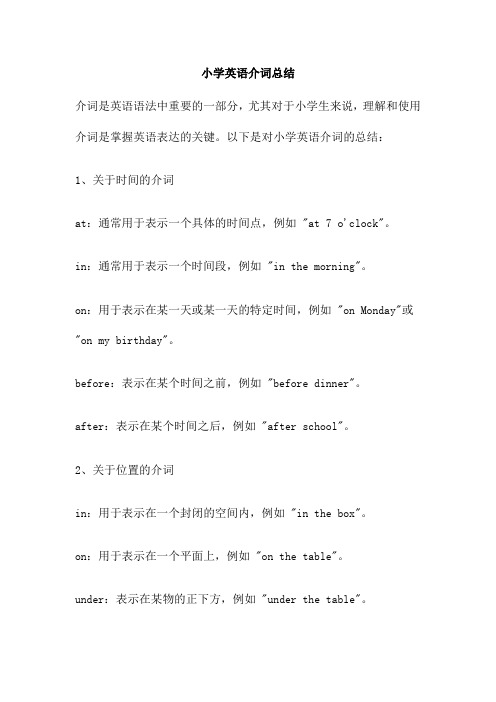
小学英语介词总结介词是英语语法中重要的一部分,尤其对于小学生来说,理解和使用介词是掌握英语表达的关键。
以下是对小学英语介词的总结:1、关于时间的介词at:通常用于表示一个具体的时间点,例如 "at 7 o'clock"。
in:通常用于表示一个时间段,例如 "in the morning"。
on:用于表示在某一天或某一天的特定时间,例如 "on Monday"或"on my birthday"。
before:表示在某个时间之前,例如 "before dinner"。
after:表示在某个时间之后,例如 "after school"。
2、关于位置的介词in:用于表示在一个封闭的空间内,例如 "in the box"。
on:用于表示在一个平面上,例如 "on the table"。
under:表示在某物的正下方,例如 "under the table"。
above:表示在某物的上方,但是不一定是正上方,例如 "above the table"。
beside:表示在某物的旁边,例如 "beside the book"。
3、关于方向的介词to:用于表示朝向某个方向或地点,例如 "go to school"。
from:用于表示从一个地方或位置到另一个地方或位置,例如 "come from school"。
towards:表示朝向某个方向或地点,但是不一定到达那里,例如"walk towards the park"。
4、关于原因的介词because:用于表示原因或理由,例如 "I am late because I missed the bus"。
小学英语语法连词介词
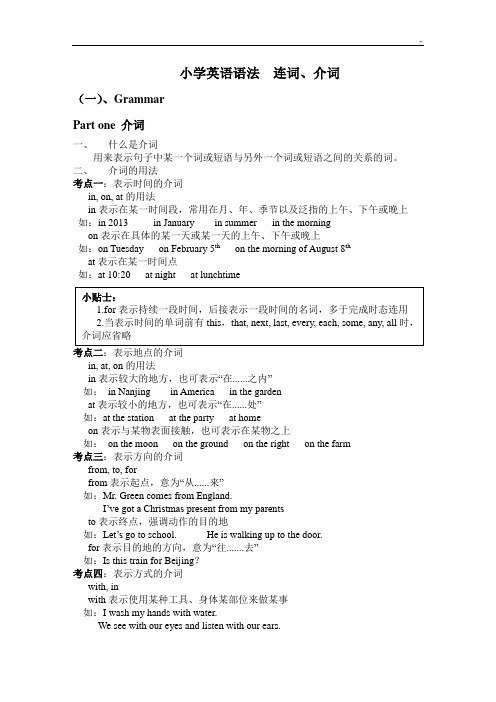
小学英语语法连词、介词(一)、GrammarPart one 介词一、什么是介词用来表示句子中某一个词或短语与另外一个词或短语之间的关系的词。
二、介词的用法考点一:表示时间的介词in, on, at的用法in表示在某一时间段,常用在月、年、季节以及泛指的上午、下午或晚上如:in 2013 in January in summer in the morningon表示在具体的某一天或某一天的上午、下午或晚上如:on Tuesday on February 5th on the morning of August 8that表示在某一时间点如:at 10:20 at night at lunchtime考点二:表示地点的介词in, at, on的用法in表示较大的地方,也可表示“在......之内”如:in Nanjing in America in the gardenat表示较小的地方,也可表示“在......处”如:at the station at the party at homeon表示与某物表面接触,也可表示在某物之上如:on the moon on the ground on the right on the farm考点三:表示方向的介词from, to, forfrom表示起点,意为“从......来”如:Mr. Green comes from England.I’ve got a Christmas present from my parentsto表示终点,强调动作的目的地如:Let’s go to school. He is walking up to the door.for表示目的地的方向,意为“往.......去”如:Is this train for Beijing?考点四:表示方式的介词with, inwith表示使用某种工具、身体某部位来做某事如:I wash my hands with water.We see with our eyes and listen with our ears.in表示使用某种语言如:Can you say it in English?一、填上合适的介词1. There is a supermarket _________ my house.2. Gao Shan is ______ duty today.3. Liu Tao often helps me ________ my study.4. My birthday is ________ October 21.5. There are lots of apples _______ the tree.6. I like reading and I can learn a lot ______ it.7. I can’t find the basketball. Maybe it’s ______ the door.8. I can buy some flowers _______ you.9. I get up ______ seven _______ the morning.10. Jack, please look _______ your things.二、根据中文提示,完成下列句子1. 墙上有许多标志。
英语语法 介词如何表示地点的位置
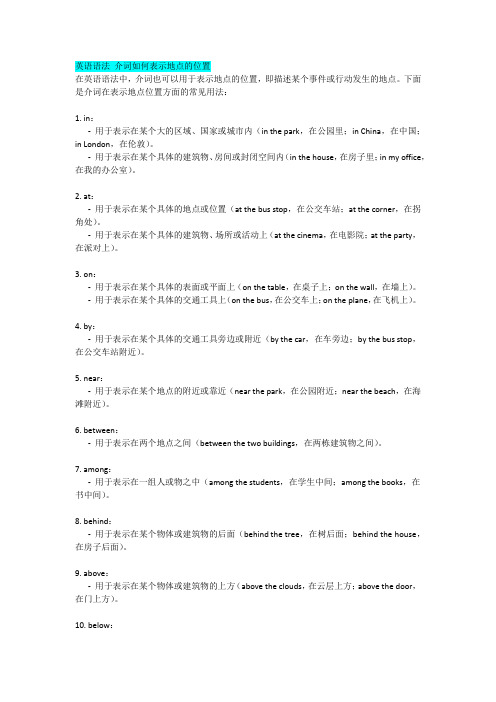
英语语法介词如何表示地点的位置在英语语法中,介词也可以用于表示地点的位置,即描述某个事件或行动发生的地点。
下面是介词在表示地点位置方面的常见用法:1. in:-用于表示在某个大的区域、国家或城市内(in the park,在公园里;in China,在中国;in London,在伦敦)。
-用于表示在某个具体的建筑物、房间或封闭空间内(in the house,在房子里;in my office,在我的办公室)。
2. at:-用于表示在某个具体的地点或位置(at the bus stop,在公交车站;at the corner,在拐角处)。
-用于表示在某个具体的建筑物、场所或活动上(at the cinema,在电影院;at the party,在派对上)。
3. on:-用于表示在某个具体的表面或平面上(on the table,在桌子上;on the wall,在墙上)。
-用于表示在某个具体的交通工具上(on the bus,在公交车上;on the plane,在飞机上)。
4. by:-用于表示在某个具体的交通工具旁边或附近(by the car,在车旁边;by the bus stop,在公交车站附近)。
5. near:-用于表示在某个地点的附近或靠近(near the park,在公园附近;near the beach,在海滩附近)。
6. between:-用于表示在两个地点之间(between the two buildings,在两栋建筑物之间)。
7. among:-用于表示在一组人或物之中(among the students,在学生中间;among the books,在书中间)。
8. behind:-用于表示在某个物体或建筑物的后面(behind the tree,在树后面;behind the house,在房子后面)。
9. above:-用于表示在某个物体或建筑物的上方(above the clouds,在云层上方;above the door,在门上方)。
【优质讲义】小学英语语法归纳训练讲义-12 介词in,on,at 全国通用版(含答案)

语法——介词in on atPart 1:学问点一、介词:是一种虚词,在句子中表示名词或代词与其他词之间的关系,不能单独做为句子成分,常位于名词或代词前面构成介词短语。
二、具体用法:常用介词1.in(1)表示方位:在……里面例句:There are three books in my bag.我书包里有三本书。
(2)表示地点:A.表示在大地方例句:I live in Hangzhou.我住在杭州。
B.表示属于该范围例句:Hei Longji ang lies in the north of China.黑龙江在中国北部。
(3)表示时间:A.表示一段时间(比较长)例:in summer在夏天in 2021在2021年in February 在二月B.表示在早上、下午、晚上例:in the morning/afternoon/evening(4)表示使用某种材料、语言等:例句:I can sing the song in English.我能用英语唱这首歌。
2.on(1)表示地点:在……上面例句:There is an apple on the desk.桌子上有一本书。
(2)表示时间:A.表示在具体某一天的上午、下午或晚上例:on June thirteenth在六月13日on the morning of May 1st在五月一日的早上B.表示在星期几的上午、下午或晚上例:on Friday在周五on Saturday afternoon在周六的下午2.at(1)表示在小地点:例:at school /home(2)表示时间点:例:at seven在七点at night在夜晚Part 2:练习一、用介词填空。
1.My mother begins to work ______ 8:00 ______ t he morning.2.Do you stay ______ home ______ weekend?3.They live ______ a new house now.4.Xinjiang is ______ the west of China.5.Lily usually have breakfast ______ the morning.6.They often have lunch ______ half past twelve.7.What’s this ______ English?8.There is a big gym ______ my school.9.She came to this city ______ 2020.10.It often snows here ______ winter.11.I will be back ______ a month.12.Don’t watch TV too much ______ the evening.13.Sally was born ______ May 11th.14.We don’t go to school ______ Saturday and S unday.15.They were happy ______ that time.16.______ the age of ten, I began to learn English.17.What do you often do ______ noon?18.______ a cold winter morning, I met her in the street.19.Mrs. Green came to Beijing ______ 2005.20.Children wake up very early ______ the morning ofChristmas Day.答案:1.at in2.at on3.in4.in5.in6.at7.in8.in9.in 10.i n 11.in 12.in 13.on 14.on 15.at 16.At 17.at 18.On 19.in 20.on。
小升初小学英语语法专题精讲:介词 地点介词 时间介词 方式介词

Practice
随堂演练:选出与所给单词同类的选项。 ( A)2. near A. in B. young C. play
Practice
随堂演练:选出与所给单词同类的选项。 ( B)3. from A. far B. outside C. sunny
Language points
4.next to,beside,near 的区别 next to意为“紧靠着”;beside意为“在。。。旁边”,位置介于next to与 near之间;near意为“在。。。附近”。例如: 门旁边有一把小提琴。 There's a violin beside the door.
Language points
2.between,among的区别 between指两者之间;among指三个或三个以上的人或事物之间。例如: 李老师正坐在孩子们中间看比赛。 Miss Li is sitting among the children to watch the match.
Language points
Practice
真题演练:选出与其余单词不同类的选项。
(B )1. A. on
B. after
C. around
解析:on与around都是表示地点的介词,after是表示时间的介词,
故选B.
Practice
真题演练:选出与其余单词不同类的选项。
(B )2. A. beside
B. for
C. between
5.Korea lies __in__ the northeast of China.
英语介词讲解

英语介词讲解介词(preposition)是一种用来连接名词、代词或名词短语与其他词或短语的词类,在句子中常常表示位置、方向、时间、关系等。
以下是一些常见的英语介词及其用法:1.in:表示在某个位置、地点、范围或状态之内。
例如:in the room(在房间里)、in London(在伦敦)、in the book(在书中)等。
2.on:表示在某个平面、表面、方向或日期上。
例如:on the table(在桌子上)、on the wall(在墙上)、on Monday(在星期一)等。
3.at:表示在某个点、时间、活动或事件上。
例如:at the park(在公园)、at 8 o'clock(在8点)、at the party(在聚会上)等。
4.by:表示通过某种方式、手段或时间。
例如:by car(乘车)、by email (通过电子邮件)、by Friday(到星期五)等。
5.for:表示为某个目的、目标或时间段。
例如:for you(为你)、for two hours(两个小时)、for breakfast(作为早餐)等。
6.to:表示朝向某个地点、目的地或对象。
例如:to the park(到公园)、to the store(到商店)、to you(给你)等。
7.from:表示起点、来源或运动方向。
例如:from the house(从房子里)、from London(从伦敦)、from Monday to Friday(从星期一到星期五)等。
8.with:表示伴随、附带或使用某物。
例如:with my friend(和我的朋友一起)、with a pen(用一支笔)、with pleasure(乐意)等。
9.about:表示关于某个主题、话题或方面。
例如:about the book(关于这本书)、about the weather(关于天气)、talk about(谈论)等。
10.of:表示属于、关于或由某物组成。
小学英语语法——介词知识点讲解+练习
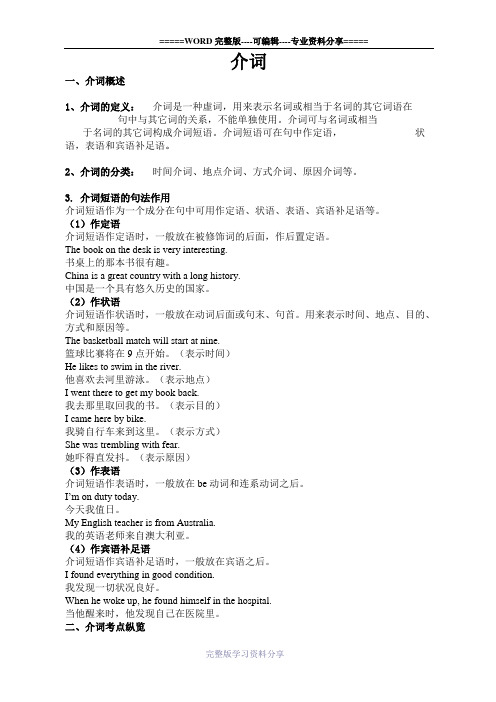
介词一、介词概述1、介词的定义:介词是一种虚词,用来表示名词或相当于名词的其它词语在句中与其它词的关系,不能单独使用。
介词可与名词或相当于名词的其它词构成介词短语。
介词短语可在句中作定语,状语,表语和宾语补足语。
2、介词的分类:时间介词、地点介词、方式介词、原因介词等。
3. 介词短语的句法作用介词短语作为一个成分在句中可用作定语、状语、表语、宾语补足语等。
(1)作定语介词短语作定语时,一般放在被修饰词的后面,作后置定语。
The book on the desk is very interesting.书桌上的那本书很有趣。
China is a great country with a long history.中国是一个具有悠久历史的国家。
(2)作状语介词短语作状语时,一般放在动词后面或句末、句首。
用来表示时间、地点、目的、方式和原因等。
The basketball match will start at nine.篮球比赛将在9点开始。
(表示时间)He likes to swim in the river.他喜欢去河里游泳。
(表示地点)I went there to get my book back.我去那里取回我的书。
(表示目的)I came here by bike.我骑自行车来到这里。
(表示方式)She was trembling with fear.她吓得直发抖。
(表示原因)(3)作表语介词短语作表语时,一般放在be动词和连系动词之后。
I’m on duty today.今天我值日。
My English teacher is from Australia.我的英语老师来自澳大利亚。
(4)作宾语补足语介词短语作宾语补足语时,一般放在宾语之后。
I found everything in good condition.我发现一切状况良好。
When he woke up, he found himself in the hospital.当他醒来时,他发现自己在医院里。
小学英语语法学习--介词讲解1

8.Up and down
这是一对反义词,up"向上",down"向下"。
Eg: Stand up, please.起立!
Sit down, please.请坐!
9.With and without
With "和……在一起"。表示伴随。Without "没有"
At表示时间的某一点。Eg: I go to school at seven in the morning.我早晨7点钟去上学。
11.Off离开,脱离
Eg: The plane is taking off.飞机正在起飞。
12.From从…来
E.g:Where are you from? I'm fromChina.
on在……上面。The book is on the desk.书在桌子上。
at在(指某一具体地点)。My mother is at the bus stop.我妈妈正在车站。
2)表示时间
in表示笼统的时间。Eg: I was born in January.我出生在一月份。
On表示具体的时间,在出现日期时使用。Eg: I was born on June 5th.我出生在六月五日。
5.In and out
这是一对反义词,in "在……里面",out"在……外面"
Eg: There is a book in my bag.在我的书包里有一本书。
Please look out of the window.请看窗外。
6.Behind and in front of
英语语法----介词Preposition(Prep.)

英语语法—-介词Preposition(Prep.)什么是介词(Preposition)?在英语语法中,介词(Preposition)是连接名词、代词、动词或形容词与其他词或短语的一类词汇。
介词用来表示位置、时间、方向、方式、原因等概念。
介词通常放置在名词或代词之前,这种结构被称为介词短语(Prepositional Phrase)。
介词的用法表示方向和位置介词在英语中经常用来表示方向和位置。
以下是常见的方向和位置介词:•in:表示在某个物体或地点之内。
例如:in the room(在房间里);in London(在伦敦)。
•on:表示接触或在某个表面之上。
例如:on the table(在桌子上);on the wall(在墙上)。
•at:表示接触或在某个特定位置。
例如:at the bus stop(在公交车站);at the front(在前方)。
表示时间介词也常用来表示时间。
以下是常见的时间介词:•in:表示在未来的某个特定时间之后或在未来某一段时间内。
例如:in an hour(在一个小时内);in September(在九月)。
•on:表示在某个具体日期或星期几。
例如:on Monday(在星期一);on July 4th(在七月四日)。
•at:表示在某个特定时间点。
例如:at 8 o’clock(在八点钟);at noon(在中午)。
表示方式和原因介词还可以用来表示方式和原因。
以下是常见的方式和原因介词:•by:表示通过某种方式。
例如:go to school by bus(乘坐公交车去学校);learn by doing(通过实际操作学习)。
•with:表示伴随或带有某种特征。
例如:go out with friends(和朋友们一起出去);a house with a garden(带花园的房子)。
•because of:表示因为某个原因。
例如:I couldn’t come because of the rain (因为下雨,我不能来);He failed the exam because of his laziness(因为懒惰,他考试失败了)。
小学英语语法知识归纳总结:介词

小学英语知识归纳总结:介词一、定义介词preposition缩写prep.,又叫前置词,表示其后的名词或代词(或是相当于名词的其他短语或从句)与其他句子成分的关系。
介词是一种虚词,不能单独在句中作成分。
二、介词的用法1、表示时间的(at 、on、in、at、before ,after、by、until、through、from、since、within)(1)at:用于表示时刻,时间的某一点。
at noon在午时at night在夜间at present目前(2)on:用于星期,某天,某一天的上午、下午、晚上(指具体的某一天时,一律用on) 如:on sunday在星期天on sunday morning 在星期天的上午 on march 8 在3月8日(3)in:用于表示周、月、季节、年、泛指上午、下午、晚上。
in 1999 在1999年in november 在11月份in summer 在夏季in the afternoon在下午过……后(未来时间)I think he will be back in an hour .我想他一小时后就会回来。
I heard that she would be back in a month.我听说她一个月后回来的。
(4)before:在……之前Wei hua got up before 7 o’clock this morning .今天早晨,魏华在7点之前起床了。
(5)after:在……之后Aafter that ,no noe should ever kill a seagull . 从那时起,任何人不得捕杀海鸥。
(6)by:在……前(时间),截止(到)……By the time i arrived ,she had already gone .在我到达之前,她已经走了。
(7)for:达……之久(表示过了多少时间),可以和一般现在时,过去时,将来时连用,但是经常和完成时连用。
小学英语语法-连词+介词
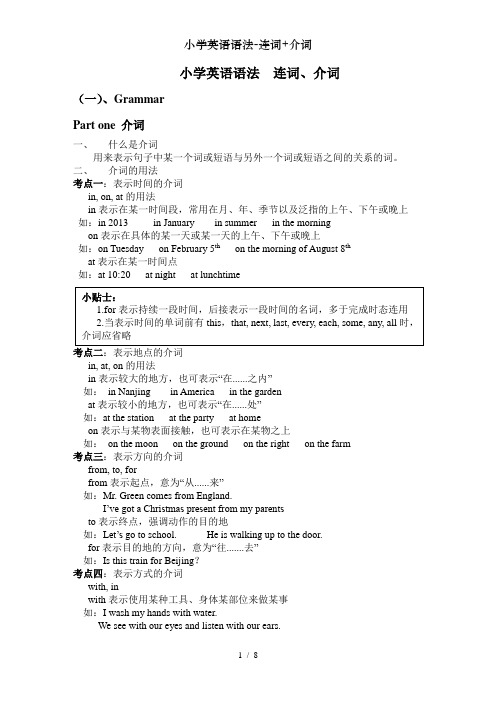
小学英语语法连词、介词(一)、GrammarPart one 介词一、什么是介词用来表示句子中某一个词或短语与另外一个词或短语之间的关系的词。
二、介词的用法考点一:表示时间的介词in, on, at的用法in表示在某一时间段,常用在月、年、季节以及泛指的上午、下午或晚上如:in 2013 in January in summer in the morningon表示在具体的某一天或某一天的上午、下午或晚上如:on Tuesday on February 5th on the morning of August 8that表示在某一时间点如:at 10:20 at night at lunchtime考点二:表示地点的介词in, at, on的用法in表示较大的地方,也可表示“在......之内”如:in Nanjing in America in the gardenat表示较小的地方,也可表示“在......处”如:at the station at the party at homeon表示与某物表面接触,也可表示在某物之上如:on the moon on the ground on the right on the farm考点三:表示方向的介词from, to, forfrom表示起点,意为“从......来”如:Mr. Green comes from England.I’ve got a Christmas present from my parentsto表示终点,强调动作的目的地如:Let’s go to school. He is walking up to the door.for表示目的地的方向,意为“往.......去”如:Is this train for Beijing?考点四:表示方式的介词with, inwith表示使用某种工具、身体某部位来做某事如:I wash my hands with water.We see with our eyes and listen with our ears.in表示使用某种语言如:Can you say it in English?一、填上合适的介词1. There is a supermarket _________ my house.2. Gao Shan is ______ duty today.3. Liu Tao often helps me ________ my study.4. My birthday is ________ October 21.5. There are lots of apples _______ the tree.6. I like reading and I can learn a lot ______ it.7. I can’t find the basketball. Maybe it’s ______ the door.8. I can buy some flowers _______ you.9. I get up ______ seven _______ the morning.10. Jack, please look _______ your things.二、根据中文提示,完成下列句子1. 墙上有许多标志。
语法重点解析介词的常见用法

语法重点解析介词的常见用法介词是英语语法中的重要部分,用于连接名词、代词、动词等成分,起到关系和修饰的作用。
本文将对介词的常见用法进行重点解析。
一、表示地点方向的介词1. in:表示在某个范围或限定的区域内。
例如:- There is a book on the table.(桌子上有一本书。
)- I live in China.(我住在中国。
)2. on:表示在平面或表面之上。
例如:- The cat is sitting on the chair.(猫坐在椅子上。
)- Please put the pen on the desk.(请把笔放在桌子上。
)3. at:表示在某个特定的位置或地点。
例如:- I will meet you at the airport.(我会在机场和你见面。
)- He is waiting for you at the bus stop.(他在公交车站等你。
)4. to:表示目标或方向。
例如:- She went to the cinema with her friends.(她和朋友们去了电影院。
)- He is walking to school.(他正往学校走。
)二、表示时间的介词1. at:表示具体的时间点。
例如:- We have a meeting at 9 o'clock.(我们九点有个会议。
)- The party starts at noon.(晚会中午开始。
)2. in:表示在某个时间段或范围内。
例如:- I usually have breakfast in the morning.(我通常早上吃早餐。
)- She will arrive in a few minutes.(她几分钟后会到。
)3. on:表示某天或某个日期。
例如:- We are going to have a picnic on Sunday.(我们打算周日去野餐。
)- His birthday is on July 10th.(他的生日是在7月10日。
小学四年级英语学习指导:介词的用法(表地点)
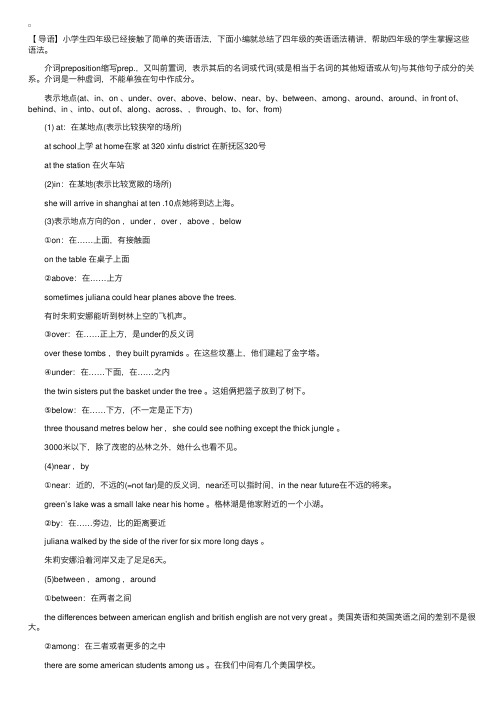
【导语】⼩学⽣四年级已经接触了简单的英语语法,下⾯⼩编就总结了四年级的英语语法精讲,帮助四年级的学⽣掌握这些语法。
介词preposition缩写prep.,⼜叫前置词,表⽰其后的名词或代词(或是相当于名词的其他短语或从句)与其他句⼦成分的关系。
介词是⼀种虚词,不能单独在句中作成分。
表⽰地点(at、in、on 、under、over、above、below、near、by、between、among、around、around、in front of、behind、in 、into、out of、along、across、,through、to、for、from) (1) at:在某地点(表⽰⽐较狭窄的场所) at school上学 at home在家 at 320 xinfu district 在新抚区320号 at the station 在⽕车站 (2)in:在某地(表⽰⽐较宽敞的场所) she will arrive in shanghai at ten .10点她将到达上海。
(3)表⽰地点⽅向的on ,under ,over ,above ,below ①on:在……上⾯,有接触⾯ on the table 在桌⼦上⾯ ②above:在……上⽅ sometimes juliana could hear planes above the trees. 有时朱莉安娜能听到树林上空的飞机声。
③over:在……正上⽅,是under的反义词 over these tombs ,they built pyramids 。
在这些坟墓上,他们建起了⾦字塔。
④under:在……下⾯,在……之内 the twin sisters put the basket under the tree 。
这姐俩把篮⼦放到了树下。
⑤below:在……下⽅,(不⼀定是正下⽅) three thousand metres below her ,she could see nothing except the thick jungle 。
- 1、下载文档前请自行甄别文档内容的完整性,平台不提供额外的编辑、内容补充、找答案等附加服务。
- 2、"仅部分预览"的文档,不可在线预览部分如存在完整性等问题,可反馈申请退款(可完整预览的文档不适用该条件!)。
- 3、如文档侵犯您的权益,请联系客服反馈,我们会尽快为您处理(人工客服工作时间:9:00-18:30)。
小学英语语法详解介词——表示地点的介词
1) 表示地点(包括动向)的介词
① at, in, on, to
at
表示在小地方:
I arrive at school at nine every morning.
我每天早上九点到校。
表示“在……附近,旁边”
The Smiths are at the beach.
史密斯一家在沙滩上。
in
表示在大地方:
When did you arrive in Beljing?
你什么时候到北京的?
表示“在……范围之内”:
The penclis in the pencl-box.铅笔在铅笔盒里。
on
表示毗邻,接壤,“在………上面”
Mongolia is on the north of China.
蒙古在中国的北面。
表示在某物体上面并与之接触:
He put his watch on the table.
他把手表放桌上。
to
表示“在……范围外”不强调是否接壤:或“到……”:
Japan is to the east of China.
日本在中国的东面。
②above, over
above指“在……上方”,不强调是否垂直,与below相对:The bird is flying above my head.
鸟儿在我头顶上飞过。
over
指垂直的上方,与under相对,over有覆盖的含义在里面:There is a bridge over the river.
江上有座桥。
③below, under
under表示“在……正下方”:
There is a cat under the table.
桌子下面有只猫。
below表示“在……下方”,不一定在正下方:
Please write your name below the line.
请在线的下方写上您的名字。
④in front of, in the front of
in front of“在……前面”,指甲物在乙物之前,两者互不包括:其反义词是behind (在……的后面):
There are some flowers in front of the house.
房子前面有些花卉。
In the front of“在……的前部,即甲物在乙物的内部,反义词是at the back of.(在……范围内的后部):
There is a blackboard in the front of our classroom.
我们的教室前边有一块黑板。
⑤beside, behind,near
beside表示“在……旁边”:
Tom sits beside Ben.汤姆坐在本的旁边。
behind表示“在……后面”:
The fountain is behind the hill.喷泉在假山后面。
near表示“在……附近”(范围比较广):
Don't stand near the lake,children.
孩子们,不要站在河边。
Near my home,there is a supermarket.在我家附近有一家超市。
⑥between, among
Between(指时间、空间、顺序等)在……之间(两者之间):
They planted a lot of trees between the two buldings.
他们在两座建筑物之间栽了许多树。
These books were written between 1736 and 1770.
这些书写于1736年至1770年之间。
(指数量、距离、程度等)介于……之间(两者之间)
He is a man between sixty and seventy.
他的年龄约在6O 到70之间。
连接着………;来往于……之间(两者之间):
There is a path between the house and the road.
有条小路将房子与出路连接起来。
among
(表示位置)处在……中,为……所环绕,为……所环抱:
He was sitig among a group of chidren, telling them a story.他正坐在一群孩子中间讲故事。
(表示范围)在……之内,在…一类之中,是……中之一,在……群中:
She is the tallest among her classmates.
她在她同学之中是最高的。
小提醒
between作为介词使用时往往会和and一起出现,如果没有出现,则后面的名词必须为复数形式,
例:
★The table is between the tree and the bench.
桌子在树和长凳的中间。
★The table is between the trees.
桌子在树的中间。
地点(动向)介词往往也会搭配一些动词,以动词词组的方式出现在句中。
⑦up/down(含义相反)
The car is running up the hill.
汽车正向山上开来。
The car is running down the hill.
汽车正向山下开去。
⑧on/of(含义相反)
We get on the train at nine and get off the train at five.
我们九点上火车,五点下火车。
⑨through/across(含义相近)
Go straignt through that door,please.请从那道门直穿过去。
We drove through the tunnel.我们开车穿过了隧道。
You must not run across the road. 你不要跑过马路。
A bridge was laid across the river.一座桥横架河上。
小提醒
across和through 都有“穿过,通过”的意思。
但across 往往指的是在物体的表面通过,而through指的是从物体的中间通过。
⑩along/by(含义相近)
She walked along the path.她沿着小路走去。
I looked along the length of the building.我的视线掠过整幢大楼。
He walked by me without speaking. 他从我身边走过,什么也没说。
My brother goes by the building every day.我哥哥每天经过这幢大楼。
小提醒
along和by虽都有“在边上”的意思,但两者在空间上略有不同。
along 更强调“沿着”,有一种延伸感;而by 可以包括附近的地带。
